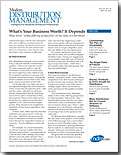
Investment Banking Directory
Work with a banking partner that knows your business. Get detailed information on investment banks with expertise in the wholesale distribution industry.
All your exclusive premium content in one location.



Not a subscriber? Subscribe today for as little as $24.80/month!
Sophisticated buyers with the same information often come to different conclusions about the value of a company. This article presents a case study that illustrates the wide spread of valuations in a transaction; it also examines why these buyers view companies so differently.
Any distribution company owner considering a sale asks himself a fundamental question: “What is my business worth?” For those companies sold in a one-off transaction, no one will ever know how the result might have been different had the competitive tension of a process with multiple parties been present – though the result is unlikely to have been worse. That genie cannot be put back in the bottle.
On the flip side, as an M&A advisor, I am regularly brought into failed situations where owners that thought they had a “full and fair value” with that one-off buyer become disappointed that the deal drags out or never yields a transaction as they had expected. These owners often turn to …
Uncertainty permeates today’s business environment. In fact, I’ve spoken with a number of distributors over the past couple of months who are holding off on expansions or hiring because of it. As National Association of Manufacturers chief economist Chad Moutray told MDM last month: “There really has been a sitting-on-the-hands mentality both on the part of consumers on businesses.”
That said, there are always …
Middle-market distributors are growing, but that growth and the optimism that accompanies it is tempered by a number of factors including weakness in Europe, rising commodity prices, continued housing crisis, and uncertainties connected with the upcoming election and policy issues, including health care.
These are the findings from a newly released Distribution Monitor report, sponsored by the NAW Institute for Distribution Excellence and McGladrey, a provider of assurance, tax and consulting services. The NAW Institute is the research arm of the National Association of Wholesaler-Distributors.
“Despite their concerns, distributors are generally …
Each hurricane season, there’s a renewed effort by many businesses to implement disaster plans, but most still do not have a formal, updated plan for business continuity. This article looks at the first steps a distributor should take to ensure that its business can keep running should the unplanned happen.
F&F Industrial Equipment, a one-branch industrial distributor in Middletown, NY, has been proactive about developing a business continuity plan in the case of disaster.
While the distributor itself has never been affected by a natural disaster or other major disruption, it has witnessed customers’ experiences with storms and other unplanned events and the havoc those can wreak if a business is not prepared.
“Knock on wood nothing happens here,” says Frank Fasano Jr., vice president of operations. But, he says, “you really never know.”
As recent events have shown, a disaster can hit anywhere. Consider …
MDM recently conducted a survey with Steve Epner and Brent Grover on how distributors manage their software applications. This article provides an overview of the results, with a focus on why many distributors have been slow to bring their software applications up to speed.
Every once in a while, we get a stark reminder that time flies. This happens often in the world of application software. All of the sudden, a company gets a notice that its current software will no longer be supported. What do you do? Upgrade? Change? Hope for a …

Table of Contents:
Are you a subscriber? Simply log-in to view this issue.`


Economic growth in the U.S. is sustainable throughout the remainder of 2007, say the nation's purchasing and supply executives in their spring 2007 Semiannual Economic Forecast. Expectations for the remainder of 2007 are encouraging in both the manufacturing and non-manufacturing sectors. These projections are part of the forecast issued by the Business Survey Committee of the Institute for Supply Management& trade; (ISM).
Manufacturing Summary
The survey panel of purchasing and supply management executives remains optimistic with 62 percent of respondents predicting revenues to be greater in 2007 than in 2006. This is reflected in their expectations of a 5.6 percent net increase in revenues for the period. To support the revenue growth expectations, ...
These charts show the top ten industries, by SIC code, consuming these products; and the 2005 end-user consumption of these groups sorted by the nine government market regions. ...

Work with a banking partner that knows your business. Get detailed information on investment banks with expertise in the wholesale distribution industry.





Build strategic sales plans.
Determine market and demand.
Create smart prospect lists.
Turn your sales data into actionable data with Market Prospector. A web-based SAAS tool that gives you insight into your market, your territories, your customers and new prospects too.
Our daily newsletter is your best source for news and trends in the wholesale distribution industry.
Wholesale distribution news and trends delivered right to your inbox.
Sign-up for our free newsletter and get:

By providing your email, you agree to receive announcements from us and our partners for our newsletter, events, surveys, and partner resources per MDM Terms & Conditions. You can withdraw consent at any time.